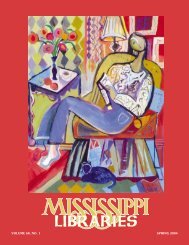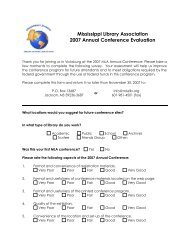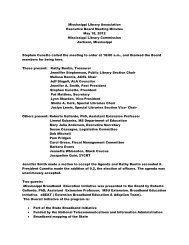Full Text (PDF) - Mississippi Library Association
Full Text (PDF) - Mississippi Library Association
Full Text (PDF) - Mississippi Library Association
You also want an ePaper? Increase the reach of your titles
YUMPU automatically turns print PDFs into web optimized ePapers that Google loves.
<strong>Mississippi</strong> Libraries Vol. 75, No. 1, Spring 2012 Page 17<br />
Hollinger boxes containing the photographs<br />
were not full, resulting in potential<br />
damage to the collection and wasted<br />
space. Condensing the boxes would mean<br />
more than moving material from one box<br />
to another, it would involve adjusting the<br />
Microsoft Excel spreadsheet, previously<br />
created, to reflect the physical changes<br />
made. Our idea was to condense the<br />
boxes and change the excel file as the<br />
items were scanned. This process worked<br />
until January 2011 when the need to complete<br />
the project became apparent. Many<br />
of the students working on the project<br />
would be graduating in May 2011 making<br />
it apparent the collection completion deadline<br />
needed to be March 2011. This would<br />
allow the Digital Initiatives Librarian the<br />
time to correct any errors and upload the<br />
collection by April 2011. Due to the selfimposed<br />
deadline, I decided to add an<br />
additional two students to the digitization of<br />
the black and white photographs. This<br />
meant that three students would be working<br />
on the photographs. In order to have<br />
more than one student working at a time<br />
on the photographs, we had to finish physically<br />
shifting the collection and update the<br />
Excel file before scanning could resume<br />
which took roughly two days.<br />
With only one student worker handling<br />
the slides, many of the slides were first<br />
scanned backwards which caused further<br />
delays. The slides were originally mounted<br />
inconsistently making the use of a light<br />
machine the only way to tell the “front”<br />
from the “back.” This was not noticed until<br />
the items were uploaded into CONTENTdm<br />
and examined more closely. Correcting<br />
the slides cost a week’s work but ultimately<br />
did little to delay the project as a<br />
whole.<br />
In addition to photographs and slides<br />
documenting the elementary and secondary<br />
schools in <strong>Mississippi</strong>, a large number<br />
of images of the University of <strong>Mississippi</strong><br />
are included. These images were not as<br />
organized as the school images; this was<br />
not discovered until the images were<br />
uploaded into CONTENTdm. While we<br />
still had metadata provided in the Excel file,<br />
when the images where uploaded they<br />
rarely matched the data. This meant the<br />
Digital Initiatives Librarian had to cross reference<br />
the image with the data to see<br />
where the confusion began and ended. As<br />
it turned out there was no rhyme or reason<br />
as to why the images did not match the<br />
data, so we did the best we could with the<br />
information we had, making sure buildings<br />
were labeled correctly.<br />
Uploading the Images<br />
In order to upload the slides and photographs<br />
of both the University of <strong>Mississippi</strong><br />
and the elementary and secondary schools,<br />
the Digital Initiatives Librarian converted the<br />
preservation copies into 100 dpi jpgs. In<br />
order to maintain control over the digital collection,<br />
all images were watermarked with<br />
the University of <strong>Mississippi</strong> seal prior to<br />
uploading. Then the metadata was cleaned<br />
up to conform to our defined search<br />
scheme and control terms were created<br />
based <strong>Library</strong> of Congress subject headings.<br />
Finally, the items were uploaded in<br />
batches which took several attempts as we<br />
corrected mistakes and made the collection<br />
more searchable for researchers. The collection<br />
can be viewed: http://clio.lib.olemiss.edu/archives/phay.php.<br />
Conclusion<br />
The digitization of the John Elon Phay<br />
Collection was productive in digitally preserving<br />
the materials while providing<br />
online access to on-site and remote<br />
patrons. Researchers in the areas of education,<br />
Southern studies, Civil Rights, history,<br />
etc… can evaluate the <strong>Mississippi</strong> educational<br />
system of the 1940s and 1950s<br />
through visual documentation. The University<br />
of <strong>Mississippi</strong> images are also vital<br />
because they document academic and athletic<br />
events across campus giving insight<br />
into its culture. The process we used to<br />
digitize the Phay collection has set precedence<br />
for how other materials in Visual<br />
Collections are processed and digitized.<br />
Because of this project, we are able to better<br />
gauge the time, cost and knowledge<br />
required to reprocess and digitize a collection<br />
of this size. The digitization of the<br />
John Elon Phay Collection was made possible<br />
because of legacy metadata, proper<br />
equipment, low costs, student assistants,<br />
and an efficient staff. <br />
Footnote<br />
(1) Bolton, Charles C., <strong>Mississippi</strong>’s School<br />
Equalization Program, 1945-1954: “A<br />
Last Gasp to Try to Maintain a Segregated<br />
Educational System,” Journal of Southern<br />
History, Nov. 2000<br />
Visit<br />
our<br />
Website:<br />
www.misslib.org














